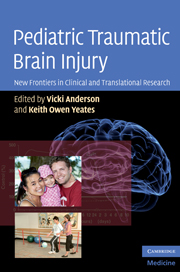Book contents
- Frontmatter
- Contents
- List of contributors
- Acknowledgments
- Introduction: Pediatric traumatic brain injury: New frontiers in clinical and translational research
- 1 Biomechanics of pediatric TBI
- 2 Neurobiology of TBI sustained during development
- 3 Using serum biomarkers to diagnose, assess, treat, and predict outcome after pediatric TBI
- 4 Clinical trials for pediatric TBI
- 5 Advanced neuroimaging techniques in children with traumatic brain injury
- 6 Neurobehavioral outcomes of pediatric mild traumatic brain injury
- 7 Very long-term neuropsychological and behavioral consequences of mild and complicated mild TBI: increased impact of pediatric versus adult TBI
- 8 Neurobehavioral outcomes of pediatric traumatic brain injury
- 9 Neuropsychological rehabilitation in children with traumatic brain injuries
- 10 Psychosocial interventions
- 11 Pediatric TBI: challenges for treatment and rehabilitation
- 12 Integrating multidisciplinary research for translation from the laboratory to the clinic
- Index
- Plate section
- References
10 - Psychosocial interventions
Published online by Cambridge University Press: 14 May 2010
- Frontmatter
- Contents
- List of contributors
- Acknowledgments
- Introduction: Pediatric traumatic brain injury: New frontiers in clinical and translational research
- 1 Biomechanics of pediatric TBI
- 2 Neurobiology of TBI sustained during development
- 3 Using serum biomarkers to diagnose, assess, treat, and predict outcome after pediatric TBI
- 4 Clinical trials for pediatric TBI
- 5 Advanced neuroimaging techniques in children with traumatic brain injury
- 6 Neurobehavioral outcomes of pediatric mild traumatic brain injury
- 7 Very long-term neuropsychological and behavioral consequences of mild and complicated mild TBI: increased impact of pediatric versus adult TBI
- 8 Neurobehavioral outcomes of pediatric traumatic brain injury
- 9 Neuropsychological rehabilitation in children with traumatic brain injuries
- 10 Psychosocial interventions
- 11 Pediatric TBI: challenges for treatment and rehabilitation
- 12 Integrating multidisciplinary research for translation from the laboratory to the clinic
- Index
- Plate section
- References
Summary
Developing and testing psychosocial interventions for pediatric TBI requires answering the key questions of: who, what, when, where, and how. As in middle school journalism, the answers to these questions fundamentally shape the story, or in this case, the nature of the intervention. This chapter focuses specifically on interventions or treatments that have been developed to address the psychosocial problems following TBI in children and adolescents. Within this scope, I have considered treatments to improve child and family adaptation including executive functions and behavior. However, interventions targeting memory and cognitive problems (i.e. cognitive retraining) are considered elsewhere in this volume. In considering the answers to the five questions, we will examine all levels of evidence from Class 1: double-blinded randomized trials to Class 4: uncontrolled descriptive studies (Edlund et al., 2004). The existing intervention literature is examined with an eye toward promising new approaches and avenues for further investigation.
Who?
Injury severity
Given that this is a volume on pediatric TBI, the answer to the question of “who” seems deceptively simple children with traumatic or acquired brain injury. However, upon further consideration the answers are considerably more varied and complex. First, there is the question of which children with respect to injury severity. The psychosocial sequelae of TBI vary widely depending on the severity of injury, and thus the nature and targets of intervention will vary correspondingly.
- Type
- Chapter
- Information
- Pediatric Traumatic Brain InjuryNew Frontiers in Clinical and Translational Research, pp. 179 - 191Publisher: Cambridge University PressPrint publication year: 2010
References
- 1
- Cited by



